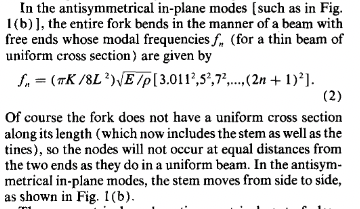On the dynamics of Tuning Forks. (Rossing, Russell, and Brown 1992)
Characterizing Tuning Forks
Aluminum, tines 10mm apart. Four main groups of vibration:
- Symmetrical In-Plane
- Antisymmetrical In-Plane
- Symmetrical Out-Of-Plane
- Antisymmetrical Out-Of-Plane

(a) and (c) are in the first group; (b) is in the second group, where the fork just warps.
Deriving Tuning Forks’ Frequency
As per before, we can treat tuning forks acting in clang and fundamental modes as a good’ol fashioned cantilever beam.
The frequency action of a cantilever beam is defined as follows:

Otherwise, for asymmetric modes, we can use the same exact expression but with uniform rods unfixed at either end:

Note that density is not uniform at this point (because the bottom handle-y bit.)